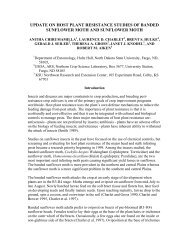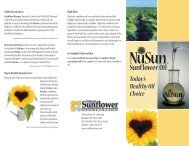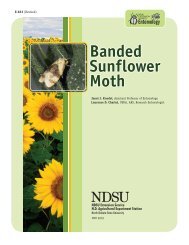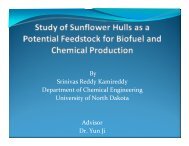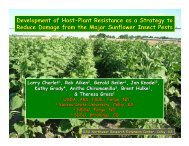Sunflower Production - NDSU Agriculture - North Dakota State ...
Sunflower Production - NDSU Agriculture - North Dakota State ...
Sunflower Production - NDSU Agriculture - North Dakota State ...
You also want an ePaper? Increase the reach of your titles
YUMPU automatically turns print PDFs into web optimized ePapers that Google loves.
II. Foliar Diseases■ RustOn most crops, rust refers to a single fungal species.On sunflower, the main fungus causing rust is Pucciniahelianthi, which is worldwide in distribution andcauses economic losses. In <strong>North</strong> America, four otherPuccinia species are found on wild and cultivated sunflower:P. canaliculata (nutsedge rust), P. enceliae, P.massalis and P. xanthii (cocklebur rust), plus one rustfrom another genus, Coleosporium helianthi. The followingdiscussion will deal mainly with P. helianthi,with minimal descriptions of the other rust fungi.Description: Rust occurs in all sunflower productionareas of the U.S. and Canada and also is widespreadon wild sunflower. Most oilseed hybrids havehad good resistance to the prevailing rust races, butchanges in the rust population in the last decadehave resulted in greater rust severity and occasionallyin substantial losses in seed yield or seed quality.Confection hybrids are generally more susceptibleto rust (and other diseases) than oilseed hybrids. Atleast 25 different rust races have been identified inthe U.S., which makes breeding for rust resistance achallenge. Rust, incited by the fungus Puccinia helianthi,is characterized by cinnamon-colored spots oruredial pustules, which primarily occur on the leaves(Figure 75) but also on the stems, petioles, bracts andthe back of the head under severe infestations. Theinitial appearance of rust is determined by adequaterainfall and warm temperatures, so the disease usuallyoccurs in late summer in the northern Great Plains.The uredial pustules turn black with the advent of cooltemperatures as the brown urediospores are replacedby black overwintering teliospores.Disease Cycle: This rust completes its entire life cycleon sunflower and does not require an alternate host, asdo some cereal rusts. Puccinia helianthi overwinterson plant debris as teliospores (thick walled, restingspores). These spores germinate in the spring toproduce basidiospores that infect volunteer seedlingsor wild sunflowers. This initial infection results in theformation of pycnia (generally on the underside ofleaves), which, in turn, leads to aecial pustules, generallyon the upper surfaces of leaves or cotyledons. Theaecia are small (1/8 inch), orange cup-shaped pustulesthat may occur singly or in small clusters (Figure 76).The aeciospores are spread by wind to other sunflowerplants, where they initiate the cinnamon-brown uredialpustules. The uredial stage is the repeating portion ofthe rust life cycle. Rust multiplies rapidly under favorableconditions of warm temperatures and either rainor dew. Thus, even in dry years, if night temperaturesare low enough to promote dew formation on leaves,this minimal amount of leaf wetness will be sufficientto initiate rust infection. Excessive rates of nitrogenfertilization and abnormally high seeding rates resultin excessive foliage, which increases humidity withinthe canopy and favors rust development.Damage: Rust not only reduces yield, but also reducesoil, seed size, test weight and kernel-to-hull ratios.Late-planted fields of susceptible hybrids are generallymore severely damaged by rust than earlier-plantedfields. Irrigated fields also are apt to have more severeinfection as the constantly wet leaves provide an idealenvironment for the rust fungus to multiply.■ Figure 75. Rust occurs most commonly on leavesand after flowering. The cinnamon-red pustulesproduce summer spores; the black pustules occur latefall and produce overwintering spores. (D.E. Zimmer)■ Figure 76. Aecial cups of Puccinia helianthi.(T. Gulya)Diseases59




